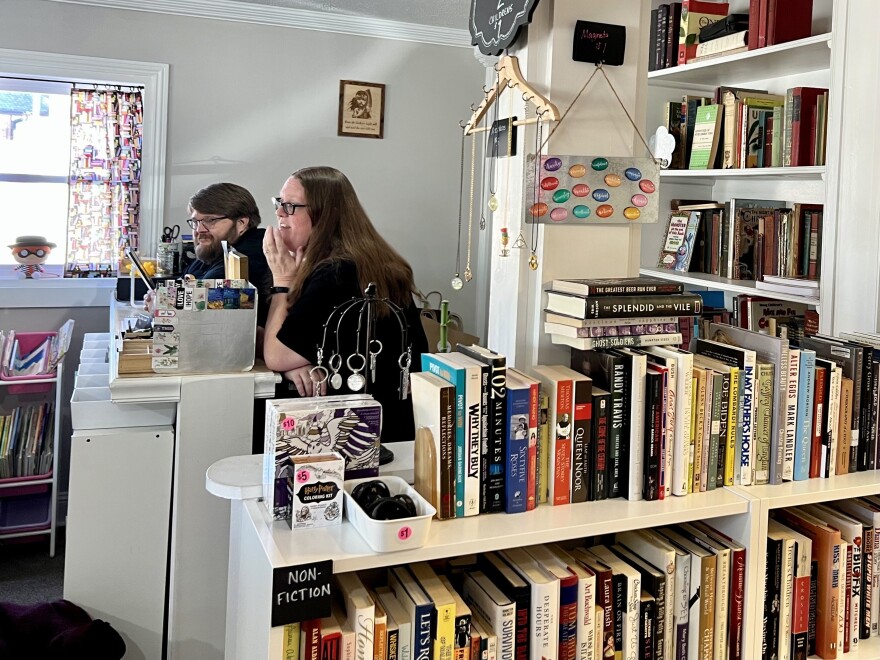At this small bookstore in southwest Ohio, there’s a cabinet lined with caution tape. Swing open the doors, and you're met with familiar titles: "Fahrenheit 451," the "Harry Potter" series, "The Great Gatsby," a creased copy of "Charlie and the Chocolate Factory."
They might seem harmless, but their place on this shelf means someone once thought they were too dangerous to be read.
“Some of them you just look at it and go, ‘Really?’,” said Rachel Collins, owner of the new bookstore, The Banned Book Nook and Other Curiosities in Wilmington.

Concerned parents and library patrons across the country are asking their local libraries to take books off the shelves. In Ohio alone, more than a hundred titles have been challenged at public libraries this year, according to the American Library Association.
Amid these pushes to restrict reading, Collins’ store is embracing the controversy. They collect and sell books that have been challenged or removed from libraries because of their content.
“It's just been overwhelming to think that this is going on now. I feel like in 2023 that should not be something we're dealing with, but it seems like it's a big topic right now,” she said.
Book challenges in Ohio
The couple opened the bookstore in early October, and Rachel has been keeping tabs on book challenges since then. She’s surprised by the number of reports coming out of schools across the country and in Ohio.
Communities across the state are debating what books are appropriate for library shelves – especially in schools. Earlier this year, Hilliard City Schools in Central Ohio debated pulling around 30 titles from the school library. In northeast Ohio, parents packed into school board meetings in May to dispute a book about Colin Kaepernick. Little Miami School District in southwest Ohio put a pause on their scholastic book fair after book content complaints.

Gayle Schmuhl, president of Ohio Educational Library Media Association, said book challenges have always been around. But, within the last few years, the effort has become a more coordinated campaign.
“It's now becoming a very organized faction of people, and that’s become their theme in life: They want to ban these books,” Schmuhl said.
There were nearly seven times more attempts in Ohio to restrict books in 2022 than two years prior. Michelle Francis, executive director of the Ohio Library Council, said many of those can be attributed to national conservative groups, like Moms for Liberty and No Left Turn in Education. She said their influence is strongly seen in Ohio.
“In a few [cases], they aren’t even residents from Ohio. They're from other states, and they saw something on social media, and they're posting or complaining,” Francis said.
An ever-changing debate
The content of challenged books has changed over the years, too. The Banned Book Nook’s cabinet of controversial literature documents around 50 years of attempts to restrict access to reading.
“Way back when, [the bans focused] on religion,” Rachel said. “But a lot more now is LGBTQA+ and sexual references.”
That’s true in Ohio, where “Gender Queer: A Memoir” and “This Book Is Gay” have sparked debate in schools over their discussion of gender and sexual identity.

Rachel admits that a banned book bookstore isn’t a substitute for a library, since the books aren’t free. But, she said, the store does price the books at $3 or less to make them as accessible as possible.
“I don't think anybody should not be able to get their hands on a book if they want to read it,” Rachel said.
The shop has other literary offerings, too – but the banned books draw in the biggest crowd. Co-owner Adam Collins said people are often intrigued to see some of their favorite books on the shelf and decide to reread them in search of what made them once outlawed. Others simply want to read about challenging topics.
Whatever the case may be, Collins said he hopes each title sparks a conversation around the freedom to read.
“People have one mindset, and they don’t think they can be changed. Books can do that.”


